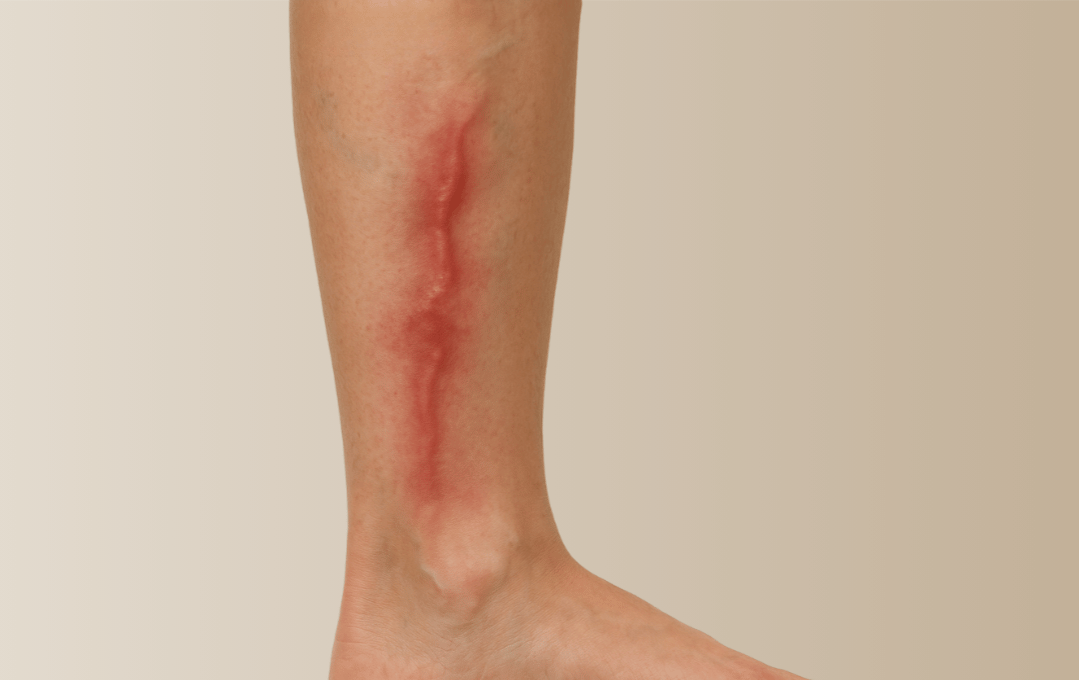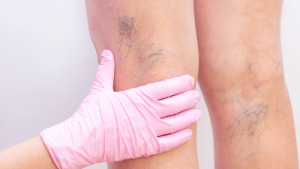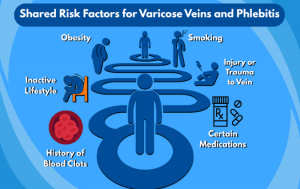
Ever noticed prominent veins on your legs and wondered what’s going on beneath the surface? While conditions like phlebitis and varicose veins involve your body’s vital blood vessels, they’re not quite the same, though they can be linked.
Your veins carry blood back to your heart through valves that operate like one-way doors, keeping the flow of blood smooth and upward.
Varicose veins occur when those one-way valves start to malfunction. Instead of shutting to prevent backflow, they weaken and become leaky, causing blood to pool and bulge under the skin.
Phlebitis is an inflammation of a vein. It is often triggered by trauma, infection, IV use, or the presence of a blood clot.
Here’s a crucial connection: While varicose veins do not directly cause phlebitis, they can increase your risk of developing it. The sluggish blood flow and altered vein structure make it easier for inflammation to occur.
This blog highlights the connection between the two, such as how slow-moving blood in varicose veins can lead to complications like clot formation and inflammation, which are hallmarks of phlebitis.
Understanding the connection between phlebitis and varicose veins can help you recognize symptoms and seek appropriate care for your vein health.
What Is Phlebitis?
Phlebitis occurs when a vein becomes inflamed or irritated. It can happen in two main places:
- Near the surface: This is referred to as superficial phlebitis. It affects veins just under your skin, which you might be able to see. You’ll usually notice redness, warmth, pain, and tenderness along the vein.
- Deep inside the body: This often involves a blood clot forming in a vein that’s deep within your muscle tissue. A much more serious condition, commonly known as Deep Vein Thrombosis (DVT), symptoms include swelling, pain, warmth, and redness in the affected limb, often the leg.
Phlebitis can be the result of:
- Trauma
- Prolonged inactivity
- Varicose veins
- IV catheter
- Underlying infections
When left untreated—especially in cases of deep vein thrombosis (DVT), where a blood clot forms in a deep vein—phlebitis can become dangerous. If the clot breaks loose, it can travel through the bloodstream to the lungs, causing a potentially life-threatening blockage known as a pulmonary embolism (PE).
Six Signs of Phlebitis
There are several signs of phlebitis to watch for, as early detection can aid in treatment before the condition escalates to more serious stages.
These symptoms of phlebitis can include:
- Pain or tenderness along a vein
- Swelling in the affected area
- Redness or discoloration
- Warmth over the inflamed vein
- A hard, cord-like lump under the skin
- General discomfort or heaviness in the limb
Symptoms of phlebitis may resemble those of other vein issues, but the presence of a hard lump or increasing discomfort can be a warning sign. You may want to see a vein specialist if you notice these symptoms developing or worsening.
The Difference Between Phlebitis and Varicose Veins
Varicose veins appear as bulging, twisted veins beneath the skin, often blue or purple in color. With phlebitis, it may look like a red streak on your leg, and the affected vein may feel hard and appear cord-like. Another noticeable difference is that phlebitis can feel warm to the touch.
Similarities Between Phlebitis and Varicose Veins
Below are some ways that phlebitis and varicose veins are similar:
- Risk factors: Prolonged inactivity, obesity, and smoking can increase the risk of both conditions.
- Symptoms: Both can cause leg pain, swelling, and inflammation.
- Both are visible near the skin’s surface.
- Both conditions may increase your risk of blood clots.
Treatment Options for Varicose Veins and Phlebitis
Risk Factors for Phlebitis and Varicose Veins
There is an overlap in the risk factors for phlebitis and varicose veins, including:
- Obesity
- Smoking
- Prolonged inactivity or a sedentary lifestyle
- Injury or trauma to a vein
- History of blood clots
- Certain medications, such as hormone therapy, refer to a broad category of medical treatments that involve using hormones (or substances that act like hormones or block their effects) to achieve a specific therapeutic effect in the body.
When to Be Concerned
Knowing when to seek medical help for phlebitis and varicose veins is crucial for your health. While symptoms of superficial phlebitis (inflammation of a vein close to the skin’s surface) often improve with home care, they may become severe or not improve with conservative care, which could indicate deep vein thrombosis (DVT).
Seek emergency care for phlebitis if you experience:
- Severe leg pain and swelling
- Shortness of breath or chest pain
- Coughing up blood
- High fever or chills
These symptoms may indicate that the blood clot from DVT broke off and traveled to the lungs, turning into a pulmonary embolism. If you experience symptoms of a blood clot, seek treatment immediately, as it may save your life.
It’s important to see a vein specialist if you notice the warning signs of varicose veins or phlebitis. The earlier either condition is detected and treated, the lower your risk is of developing more serious complications.
Schedule a Consultation Online Today
What’s the Difference Between Thrombophlebitis and Varicose Veins?
Thrombophlebitis refers to inflammation of a vein caused by a blood clot. This condition can occur in superficial veins (superficial thrombophlebitis) or deeper veins (deep vein thrombosis).
Varicose veins are primarily a structural issue involving stretched and damaged veins that don’t necessarily involve inflammation or clots, although they can develop over time.
Can You Get Phlebitis After Varicose Vein Treatment?
It is possible to develop phlebitis after varicose vein treatment; however, this is a rare complication that affects fewer than five percent of patients, according to the Journal of Vascular Surgery. Following vein treatment, mild inflammation may occur as part of the healing process. However, any persistent pain, swelling, or a hard, tender vein could signal phlebitis. If symptoms worsen or do not improve within a few days, they should be evaluated by a medical professional.
When to Seek Care for Varicose Veins or Phlebitis
If you start to notice symptoms of phlebitis or varicose veins, early intervention can help prevent long-term complications and the development of serious issues like DVT.
USA Vein Clinics offers effective, minimally invasive treatments across multiple, accredited locations nationwide. These FDA-approved treatments are accepted by most health insurance plans. Patients can verify their coverage when scheduling their appointment.
Leg pain, swelling, and other symptoms of varicose veins and phlebitis shouldn’t be ignored. See a vein specialist to start your path to healthier legs.
Consult with a Vein Specialist
FAQs About Phlebitis and Varicose Veins
Can you have phlebitis and varicose veins simultaneously?
You can experience phlebitis and varicose veins at the same time. In fact, varicose veins often lead to phlebitis due to poor blood circulation and the formation of blood clots.
What causes phlebitis without varicose veins?
There are several causes of phlebitis, such as IV use, trauma, prolonged inactivity, blood clotting disorders, and certain medications, even in those without varicose veins.
Is Phlebitis Dangerous if Left Untreated?
Phlebitis is dangerous if left untreated, especially if it progresses to DVT or causes a pulmonary embolism.
Can Compression Stockings Help Prevent Phlebitis?
Compression stockings can help prevent phlebitis by improving circulation and reducing the risk of clot formation.
What does Phlebitis Feel Like Compared to Varicose Veins?
Compared to varicose veins, phlebitis causes localized pain, redness, and warmth, often accompanied by a hard lump; whereas varicose veins typically feel achy or heavy and appear bulging or twisted.





